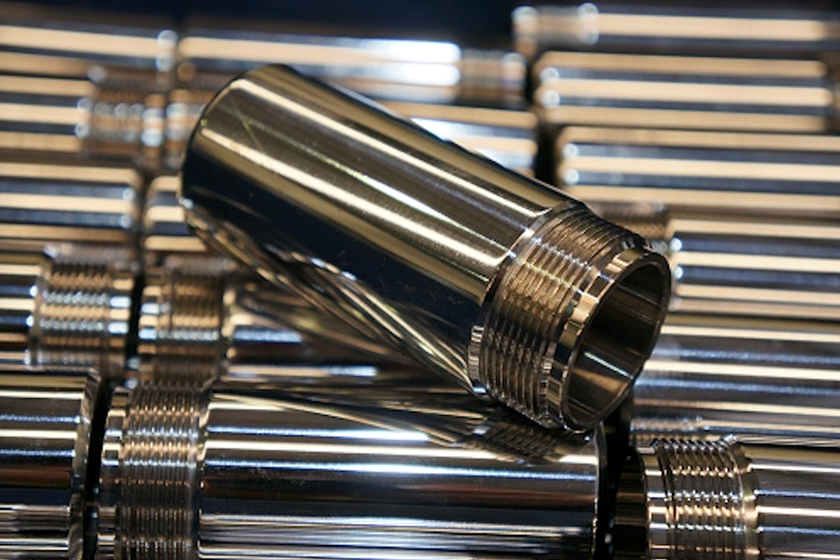Loading Vibratory Finishing Bowls for Optimal Quality
Foremost in the understanding of vibratory bowl loading efficiency is a basic understanding of theoretical versus actual working capacity of the machine.
Foremost in the understanding of vibratory bowl loading efficiency is a basic understanding of theoretical versus actual working capacity of the machine.
Manufacturers design and quote vibratory equipment by the machine’s total volumetric displacement, also known as the equipment’s theoretical volume, which represents the mass that will completely fill the bowl’s operating channel to the brim.
Featured Content
In practical operating circumstances, the theoretical volume can never be achieved because as soon as the machine is started, media will overflow the brim of the bowl. Therefore, when considering vibratory equipment, the operator must be cognizant of the actual working volume—about 80 percent of its theoretical volume.
Determining Volume
The operating channel in a vibratory bowl is the shape of a bagel, or toroid. When the volume of a vibratory bowl is unknown—for instance, when purchased used without an operating manual—it is possible to calculate the bowl’s volume using the volume formula for a toroid as ¼π2(R + r)(R – r)2 where R = distance O.D. wall to toroid center and r = distance I.D. wall to toroid center
Using the bowl dimensions in Figure 1, volume can be calculated using the toroid formula as follows:
1. Volume = ¼π2(R + r)(R – r)2
2. R + r = 26.875 inch + 8.875 inch = 35.75 inch
3. (R–r)2 = (26.875 – 8.875)2 = (18)2 = 324 inch3
4. ¼π2 = (0.25)(3.14)2 = (0.25)(9.86) = 2.47
5. (2.47)(35.75)(324 inch3) = 28,610 inch3
6. 28,610 inch3 ÷ 1,728 inch3/ft3 = 16.56 ft3
Calculating Part Volume
The first step in determining the proper loading rate for a vibratory bowl finishing operation is to determine the volumetric displacement of the parts to be processed. The part’s length, width and height must be accurately measured. Once these dimensions have been obtained, it is possible to determine the volumetric displacement of the parts.
Let’s say we have a part with the following dimensions: length = 16.5 inch, width = 1.125 inch, height = 0.75 inch. Volume of this part is: volume = (16.5 inch) (1.125 inch) (0.75 inch) = 13.92 inch3.
The question now remains: How many pieces can be placed into a cubic foot of volume? The answer will determine the practical loading limitations for the vibratory bowl. This load number can be determined as follows:
One Cubic Foot Volume: 1 ft3 = (12 inch)3 = 1,728 inch3
1,728 inch3/ft3 ÷ 13.92 inch3/pc. = 124 pcs/ft3
These simple volumetric calculations can be applied to steel parts, which traditionally represent approximately 80 percent of workloads in vibratory finishing. However, not all steel parts can be fit into this calculation model.
Although they can be processed by vibratory finishing, there are parts that due to geometric shape, metallurgical softness or weight density, have to be processed with additional considerations relative to damage that may occur during the finishing cycle.
Long, Skinny-Shaped Parts
Part dimension and weight will have an impact on the efficiency with which a vibratory bowl can be loaded, and both can affect the rolling pattern possible in the vibratory bowl and the propensity for the part to cause part-on-part damage.
Exceptionally long parts are problematic in that their length can cause a phenomenon known as log-jamming in the vibratory bowl. This is especially true if the overall length of the part matches the width of the channel. When this occurs, parts can and will jam sideways in the channel to create a dam behind which other parts and media will build-up. The result is an overflow of media and parts. (See Figure 2.)
To minimize this, a long-radius vibratory bowl is typically used when finishing long, skinny parts. The center hub of a long-radius machine has a wider diameter compared with the width of the operating channel. The narrow channel physically prevents long-shaped parts from turning sideways and jamming the channel. The helical roll of parts in a long radius bowl is akin to a javelin in flight.
Any short-length segment of the operating channel in a long radius vibratory bowl; despite its slight arc, is essentially a short-length section of straight channel.
Processing Heavy Parts
In high-quality decorative finishing applications, parts weighing more than 1 lb should be processed to avoid part-on-part contact. Lighter weight parts harder than Rc 40 will rarely incur part-on-part damage. Parts heavier than 10 lbs should be processed in compartmentalized vibratory equipment or processed uniquely to prevent damage.
Compartmentalized vibratory bowls or tubs permit multiple part processing in which each part is processed in its own compartment. This ensures 100 percent protection against part-on-part damage when either exceptionally heavy, exceptionally delicate or metallurgically soft parts are being finished.
Part Orthographic Projection
When considering bowl loading, it’s important to consider a part’s loading using its orthographic projection. This is exceptionally important when a part is fragile or metallurgically soft. To avoid part-on-part damage, these can’t be processed in high volume. Calculating true volume and loading rate won’t represent practical loading rate because of the delicate part nature.
When situations like this occur in the vibratory room, the correct way to determine the part’s load rate is by calculating its volume using its orthographic projection, whereby only the object’s length is considered as the item’s volume measurement. Using the object’s length, volume is projected as the sphere that would be created if the object is rotated on its X, Y and Z axes. (See Figure 3.) The volume of a sphere is Volume = (4/3)(π r3) where r = radius of the sphere.
Illustrative Calculation
Let us assume that the long cylinder shown in Fig. 3 is eight inches in length. The radius of the resultant sphere would be four inches. The orthographic volume for this part would be:
1: (4/3) = 1.33 3: r3 = (4 inch)3 = 64 inch3
2: π = 3.14 4: (1.33) (3.14) (64 inch3) = 267.28 inch3
Knowing that the part occupies an orthographic volume of 267.28 inches3, it is possible to calculate the number of pieces that will occupy one ft3 of volume as 1,728 inch3/ft3 ÷ 267.28 inch3/pc = 6.47 pcs, or to be safe, the practical loading limit for this part would be 6 pcs/ft3 of actual vibratory bowl volume.
Part-on-Part Impingement
Without a doubt, the biggest contributor to poor part quality during vibratory finishing is part-on-part impingement damage, typically occurring when the desire to maximize productivity overrides the practical loading limits of the machine.
The onset of part-on-part impingement damage is additionally exacerbated by the physics of the shape of the toroid and the rolling pattern in the vibratory bowl.
Figure 4 shows a three-quarters view of a vibratory bowl. It is easy to see that the I.D. center hub is a smaller diameter circle than the O.D. wall of a vibratory bowl. As parts roll in the vibratory mass, they move from the O.D. wall toward the center hub. As a result of this rolling action, the parts get closer together near the smaller diameter center hub.
Figures 5 and 6 show the differences in two rolling patterns. In Figure 5, a closed spiral pattern, the parts roll four times per lap around the bowl channel. In Figure 6, they roll eight times.
Each discrete section of a traditional vibratory bowl channel is actually pie-wedged in shape. The distance from trailing edge to leading edge of the pie wedge on the center hub side of the wedge is a shorter distance than the distance on the O.D. side of the wedge. Since parts progress a shorter distance to achieve one quarter or one eighth of the toroid’s channel length when they are closer to the center hub, the parts are consequently in closer proximity to one another, fostering potential for part-on-part contact. This is especially true in heavily loaded vibratory bowl situations.
As noted earlier, metals have different characteristics. Most important of these relative to vibratory processing is hardness. As parts roll downward at the center hub of a vibratory bowl, they are under compressive loading from the media mass above. This can result in media impingement on a metallurgically softer metal, whereby a piece of media is trapped against the vibratory bowl’s I.D. wall and the part, in addition to the close part-on-part proximity caused by the pie-wedged shape of that portion of the bowl channel.
Contact William P. Nebiolo at REM Surface Engineering, 860-621-6755.
RELATED CONTENT
-
Glass Bead Blasting as Plating Pretreatment
What are the best practices for using blasting in preparation for plating? Angelo Magrone of Bales Metal Surface Solutions discusses the ins and outs of glass bead blasting.
-
What’s in a Burr?
An unclear definition has led to an industry standard for classifying burrs.
-
High Fives for the Surface Finishing Industry
National Surface Finishing Day offered what seems to have been a missing component in our makeshift gatherings over the past year, which is a chance to celebrate together.


.jpg;width=550;quality=60)

.jpg;width=860)
















